| | Working with the weather | Understanding your weather and climate | Weather , climate and pasture growth | Risk management
Working with the Weather
Forage yield and variability are closely tied to weather and climate. Although you can't control the weather, you can manage your pastures to deal with the challenges of your local conditions. By working with the weather, you can improve pasture productivity and reduce drought risk, while also contributing to a healthy environment by reducing soil erosion, improving water quality and maintaining wildlife habitat.
Accurate information on your farm's weather and climate, soils, forage plants and riparian areas provides a solid foundation for your pasture management strategies. And good pasture management results in healthy, vigorous plants that are better able to access moisture and withstand drought.
Good management practices include:
- Delaying spring grazing until plants are ready.
- Setting your stocking rates to the average level of forage expected, with adjustment for the present year.
- Providing plant rest periods and grazing forage at appropriate stages.
- Managing pasture fertility.
- Using annuals and winter annuals.
- Selecting forage species adapted to your area.
- Carefully managing grazing of riparian areas.
- Distributing livestock evenly.
- Ensuring all these practices work together by developing and using a grazing plan.
Understanding Your Weather and Climate
Paying attention to your weather and climate will help you to better anticipate weather patterns and adapt your pasture management practices as needed. Most farmers have a general idea of the weather and climate in their area. However, extreme events may stand out in a person's memory more than routine conditions. So it's a good idea to use the records from your local weather station, and even better if you keep a record of precipitation and temperature on your own farm.
Alberta's climate
Alberta has a dry climate with cold winters and warm summers. Droughts are a recurring feature of our climate and can be expected in any part of the province. While severe and prolonged droughts are rare, they do occur. Alberta has a continental climate, which means the seasonal temperature range can be extreme.
Information on both long-term averages and year-to-year variations in the weather is useful in planning and making decisions on pasture management.
Long-term averages: Table 1 provides 30-year averages for precipitation and heat units (growing degree-days) for locations across Alberta. A 30-year period is used because it is long enough to minimize the effects of short-term extremes, but short enough to describe the current trends.
Growing degree-days indicate the heat units available for crop growth. The growing degree-days for a given day represent the number of Celsius degrees that the day's average temperature is above a given base temperature. For crop growth, the base temperature conventionally has been 5°C. The sum of the growing degree-days from April through October is the growing season total (Table 1).
On average, Alberta's warmest and driest area is the southeast corner, and the climate gets cooler and wetter as you go west or north. West central Alberta has the coolest growing season because of its higher elevation and proximity to the mountains. The southeast has over 650 more growing degree-days than west central Alberta. This additional amount of heat is similar to having over two months more of 15°C weather. Perennial forages grow more rapidly and are more productive with warmer days, if moisture and other growing conditions are not limiting.
Variability: Year-to-year variability can include minor differences from the average conditions as well as extreme events, such as severe and/or prolonged droughts, and record breaking heat, cold, wind and rainfall. Even if an extreme event has not occurred in an area for the past few decades, that does not mean the area is safe from such an event. Producers in all regions of Alberta need to consider pasture management options to deal with short-term drought, prolonged drought and unusually wet conditions.
Farm climate and weather
Your farm's weather and climate may be different from the conditions at the nearest weather station. Factors influencing farm climate and weather include elevation, slope direction, position along a slope, landscape features, soil type, sheltering by trees or other features, and distance from water bodies. Local variations in weather and climate can have a big effect on pasture production, forage species selection, maturity times and stocking rates.
Difference Between Weather and Climate
Simply put, climate is what you expect, and weather is what you get. Weather is what is happening in the atmosphere now and over a short period of time. It is described as wet or dry, hot or cold, cloudy or clear, and windy, stormy or calm. Weather information is helpful in such things as adjusting stocking rates. Climate is the long-term average weather conditions that describe what generally happens. Climate information is useful for such things as selecting forage species.
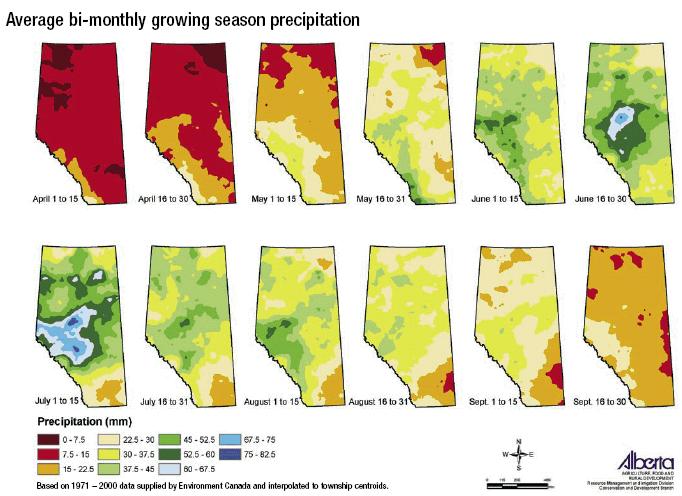
Figure 1. Average bi-monthly growing season precipitation in Alberta, April to September, 30-year averages (1971-2000)
Weather, Climate and Pasture Growth
Moisture timing
Forage production in Alberta from tame and especially native pastures is strongly tied to the moisture available before July 1 (Figure 1). As much as 60 to 70 per cent of total forage production occurs before this date in most years. If the spring is dry, overall forage production will generally be reduced, even if late summer rains arrive.
The supply of moisture and the timing of precipitation influence forage growth. Across the province, on average approximately 25 per cent of precipitation falls in the winter, from October to March (Figure 2). The amount of precipitation occurring in late summer, early fall and over-winter snow accumulations, influences the amount of moisture available for early spring growth. The proportion of annual precipitation that falls between April and September varies from north to south. In southern Alberta, the peak precipitation period is May to July. In central Alberta and in the Peace Region, the peak period is June to August.
In southern Alberta, in the Brown and Dark Brown Chernozemic soil groups, perennial forage growth depends mainly on moisture available from April to June. Winter precipitation does not necessarily have a large impact; there can be low winter precipitation and above-average forage production, and vice versa. Native forages are particularly dependent on an early supply of moisture, while tame forages and annual forages may regrow with summer rain.
In central Alberta, in the Black Chernozemic and Gray Luvisolic soil groups, summer rains are critical for good forage production.
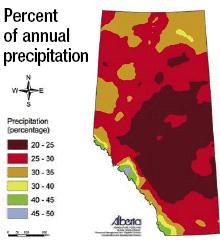
Based on 1971 to 2000 data from Environment Canada,
Alberta Environment and the U.S. National Climate Data Center.
Figure 2. Percent of average annual precipitation
received between October and March, 30-year averages
(1971-2000)
However, spring soil moisture has a significant impact on perennial forage production by supplementing crop water needs during dry periods early in the season. Winter precipitation has a bigger influence on spring soil moisture than in southern Alberta, mainly because more snow cover is retained in central Alberta.
In the Peace region, in the Dark Gray Chernozemic soil group, spring precipitation is a relatively low proportion of annual precipitation. Early forage production depends mainly on stored soil moisture, while summer growth depends on rainfall. This region tends to accumulate more moisture in the fall and winter, replenishing soil moisture reserves.
Plant growth and root systems
Maintaining healthy, vigorous forage plants is the key to making the most of available soil moisture. Vigorous plants have deep, extensive root systems that are very efficient at harvesting moisture at lower depths, so they are less affected by short dry spells and initially less affected by drought.
Most perennial plant species are capable of extensive rooting, but they require good management to reach their rooting potential. Plants stressed by overgrazing, dry conditions, low soil nutrient levels or poor soil structure have smaller and shallower root systems.
Grazing management has a significant effect on rooting depth. If the plant is given adequate time to recover from grazing, both leaves and roots regrow. Severe continuous grazing without time for plant recovery reduces total root biomass and rooting depth within a single growing season (Figure 3). This diminishes the plant's ability to access moisture and nutrients, and reduces forage yield and stand persistence. Overgrazing can also result in shallow-rooted species replacing deep-rooted species, reducing forage production and management flexibility.
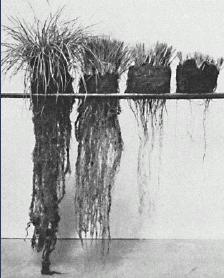
Figure 3. Greenhouse sods of rough fescue
clipped to simulate no grazing, moderate grazing,
heavy grazing and very heavy grazing (left to right)
Source: A. Johnston. 1961. Canadian Journal of Plant Science. Volume 41, pages 615-622.
Early spring grazing can be especially stressful to forage plants. Plants use root reserves as an energy source to grow in the spring until there are enough leaves converting solar energy into plant energy through photosynthesis. If the first leaves are continually grazed off, root reserves will be continuously used to grow more leaves. If these reserves are depleted, the plant will ultimately die. Plants need time to replace root reserves used for early growth before being grazed.
Peak production for many forage species occurs in June as the daylight hours lengthen (Figure 4). The greater the leaf area going into the longest day of the year, the greater the photosynthesis production for plant growth, and the greater the potential for the root system to access nutrients and moisture.
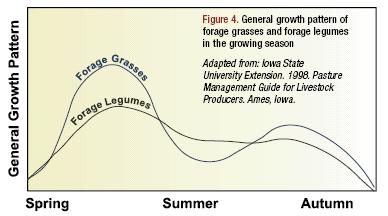
Figure 4. General growth pattern of forage grasses and forage legumes in the growing season
Adapted from: Iowa State University Extension. 1998. Pasture Management Guide for Livestock
Producers. Ames, Iowa.
Ground cover
Ground cover is vital to healthy pastures. Ground cover includes both live plants and litter. Litter is dead and decaying plant material from previous forage crops that accumulates on the soil surface (Figure 5).
Ground cover provides important benefits to forage stands. It increases soil moisture by reducing runoff, increasing infiltration, reducing evaporation, shading the soil surface in the summer, and trapping snow in the winter. It also protects soil from erosion, provides wildlife habitat, returns nutrients to the soil, and increases soil organic matter, which also increases the soil's water-holding capacity. The moisture and soil quality benefits contribute to healthy plants, which are efficient water users.
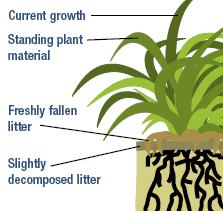
Figure 5. Litter Types
Adapted from: Adams et al. 2004. Range Health
Assessment for Grassland, Forest and Tame Pasture.
Alberta Sustainable Resource Development, Publication No. T/044
Measuring precipitation and temperature on your farm
You can monitor weather conditions on your farm with a rain collector and a max-min thermometer. This equipment does not have to be expensive. Follow the manufacturer's instructions for locating and operating the equipment. If instructions are not available, follow these tips.
Rainfall
- Place the rain collector in a sheltered area because wind can result in a significant under-catch of rain. A clearing surrounded by trees can be a good location, but the collector should be 30 to 50 m away from the trees, depending on tree height and spread. The farmstead can also be a good location if there is good wind shelter and the 30 to 50 m spacing can be maintained from buildings and trees.
- Place the collector about 50 cm above the ground or plant canopy. Ensure that plants do not grow above the collector and that there are no objects within about 1.5 m of the collector. Such obstructions may either deflect rain away from or into the collector.
- Make the collector level, and anchor it firmly so it does not move in the wind or go off level.
- Pour about 2 to 10 mm of mineral oil into the collector to minimize evaporation.
- Read the collector daily, and maintain records.
- Empty the collector regularly to ensure sufficient storage is available for large events.
Temperature
- Place the thermometer in a shaded area with good air circulation and preferably near the rain collector.
- Read the thermometer daily, and maintain records.
Snow cover
- Many producers use only snow depth to measure winter precipitation, but snow varies in the amount of water it contains. To measure snow depth, use the rain gauge site criteria to locate a site, then place a board, painted white, on level ground and stake so it is visible under a snow pack. Use a ruler to measure the snow accumulation on the board, considering you may need several boards at different locations. The equivalent depth of water will be about 1/10th the depth of the snow, but this can vary between 1/15th and 1/7th, depending on the density of the snow pack.
- Measuring the amount of moisture in a snow pack (snow water equivalent) can be tricky. The amount of water depends on the snow pack's density and depth. To calculate the amount of water, take a core sample of a known volume of snow and melt it. The depth of melted water is equivalent to the amount of moisture the field trapped. Collect samples at regular intervals, either daily or weekly during the winter, at the same time of day or same day of the week. Since snow will drift, you may need to use several locations and average the measurements each time.
Risk Management What You Can Do
Know your local weather and climate
Accurate information on weather and climate can help in managing weather-related risks to forage productivity. Weather information recorded on your farm and data from the nearest weather station provide the best sources of information. Key actions are:
- Measure precipitation and temperature at your farm (see previous page). You may want to take measurements on several fields because variations between locations can be significant.
- Keep a record of precipitation and temperature, and compare it with forage production to track trends.
- Review long-term weather data for your area to better anticipate weather patterns and understand the variability.
Current and historic weather information is available from Environment Canada. More information on Alberta's climate is available in Alberta Agriculture, Food and Rural Development's Agroclimatic Atlas of Alberta (Agdex 071-1) and on the Agriculture and Climate Information Viewer available online.
Know your local soil
Soils vary across regions and across individual fields. Knowing both the variation in and the capability of your soils is essential for optimum forage production. Key actions are:
- Learn the limitations of your soil group (Figure 6).
- Identify local variations in soil organic matter, fertility, drainage and other soil characteristics that affect plant growth.
- Determine the soil texture in your pastures to better understand water infiltration, drainage, and storage potential and limitations.
- Determine the occurrence and extent of any problem soils in your fields, and manage them appropriately. Choose forage species tolerant of the problem soil's limitations.
For more information, refer to the Alberta Soil Information Centre.
Know your mainforage species
Identify the main forage species in your pastures, and understand their growth patterns, limitations and management. Grow forage species that are productive, adapted to your environment, and suited to your grazing management system. For more information on forage species, refer to Alberta Agriculture's Alberta Forage Manual (Agdex 120/20-4), Varieties of Perennial Hay and Pasture Crops for Alberta (Agdex FS120/32) and Establishing Perennial Hay and Pasture Crops (Agdex FS120/22-2).
Conduct periodic assessments of your pastures to monitor their health. For more information on health assessments, refer to Alberta Agriculture's Tame Pasture Scorecard (Agdex130/10-1), Alberta Sustainable Resource Development's Rangeland Health Assessment Tools for Native Grasslands, Forest and Tame Pasture
(http://www.srd.gov.ab.ca/), and Cows and Fish's Riparian Health Assessments for Streams, Sloughs, Wetlands and Lakes (www.cowsandfish.org/health.html).
Know your riparian areas
Riparian areas are the lands adjacent to streams, rivers, lakes and wetlands, where the vegetation and soils are strongly influenced by the presence of water. Riparian areas provide a buffer and filter to improve and maintain water quality, as well as shelter and habitat for livestock and wildlife. They hold water, which improves forage production and provides drinking water. The key to maintaining healthy riparian areas is to understand how they function.
For more information, as well as specific management strategies, refer to Cows and Fish's Caring for the Green Zone: Riparian Areas and Grazing Management (www.cowsandfish.org/greenzone.html).
Use good pasture management methods
- Delay spring grazing until plants are ready. In general, grazing of perennial pasture species before early to mid June stresses plants because the carbohydrate reserves in their roots are low. Early grazing can reduce forage production significantly for the rest of the growing season. As a rule of thumb, one day's delay in spring grazing adds three days of grazing in the fall.
A general rule is to wait until grass plants have at least three full leaves before grazing in spring. If you cannot delay grazing on all pastures, then alternate the pastures or paddocks grazed first in the spring. Allow the early grazed pasture a long rest period afterwards.
- Set your stocking rates to the average level of forage expected, with adjustment for the present year. Stocking rates are best set conservatively for average forage production. In good years, extra forage can be grazed in the fall or left to accumulate as litter. In drought years, stocking rates may need to be reduced to match forage supply.
- Provide plant rest periods and graze forage at appropriate stages. A well planned rotational grazing system allocates adequate rest and grazing periods. This increases forage utilization and allows more uniform grazing. Be sure to monitor forage condition and adjust grazing and rest periods throughout the grazing season.
- Manage pasture fertility. Forage production in many pastures in Alberta is limited by low soil fertility. Soil test to determine fertility needs. To increase fertility, apply manure or commercial fertilizer, use winter feeding on pastures, increase manure distribution during grazing, or add legumes to the forage stand.
- Use annuals and winter annuals. Fall-seeded winter annuals, like fall rye, winter triticale or winter wheat, can be used for early spring grazing instead of perennial pastures. In a dry year, spring-seeded winter or spring cereals may provide good quality grazing throughout the season; they respond to light showers with more growth than perennial forages. In a year with more moisture, extra feed can be baled and stored.
- Select forage species adapted to your area. Choose forages recommended for your soil group and average moisture level. In drier areas, select deep-rooted, drought-tolerant species. Alfalfa is generally deeper rooted than tame grasses. In higher moisture areas, clovers make a viable legume alternative to alfalfa. Clovers are more palatable than alfalfa as the plants mature, so they are better for fall grazing. Legumes are valuable in pastures because they fix significant levels of nitrogen. In stands with a high proportion of legumes, manage bloat through grazing management.
- Carefully manage grazing of riparian areas. Avoid grazing riparian areas in the early spring and after heavy rains, when the soil is very moist. When saturated, riparian areas are vulnerable to trampling, which damages the health and function of these sensitive areas. Allow adequate time for pasture regrowth on riparian areas prior to winter. Provide off-site watering for livestock, and place livestock shelter, feed and mineral supplements away from riparian areas to protect these areas and to prevent manure build-up near water bodies.
- Distribute livestock evenly. Periodically change the locations of livestock water, shelter, feed and mineral supplements to minimize overgrazing and manure build-up around these areas.
A great way to ensure that all these strategies work together is to create and use a grazing plan. Develop your plan on paper before the grazing season starts. When creating your plan, remember to:
- coordinate grazing with pasture conditions and management events (e.g. weaning),
- account for changes in stocking rates during the grazing season, and
- show when stock will be in each pasture.
During the grazing season, monitor your pastures and adjust your plan as needed.
For More Information
By managing pastures for your weather and climate, you can improve productivity while contributing to a healthy environment. To learn more about tame pasture, range, and riparian health assessments, drought management, soil groups, problem soils and forage species selection, contact the Ag Info Centre at 1-866-882-7677 (toll-free in Alberta), or visit the following websites:
Source: Agdex 075-3. March 2006. |
|